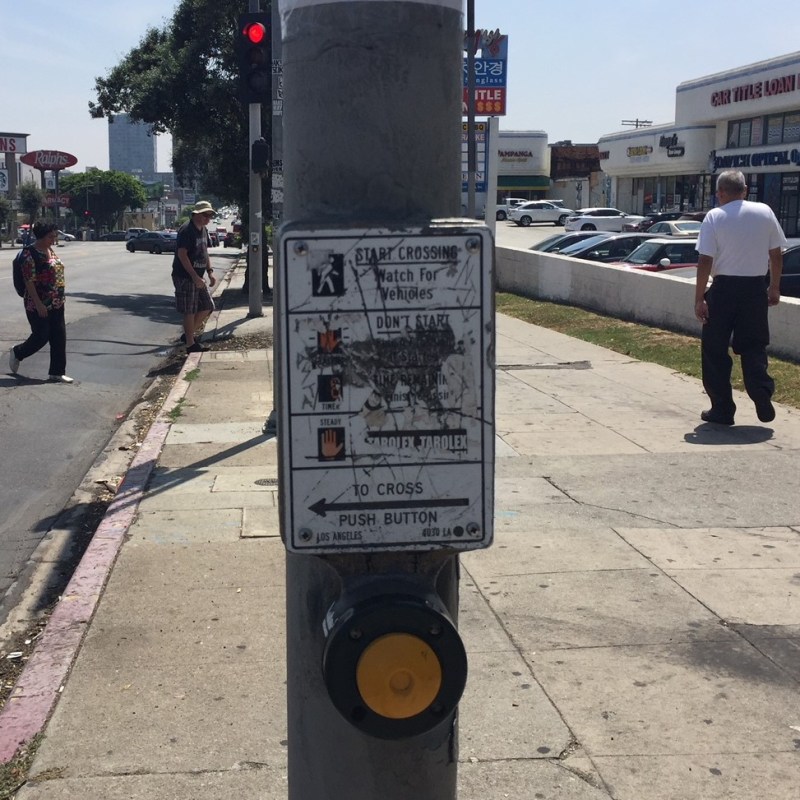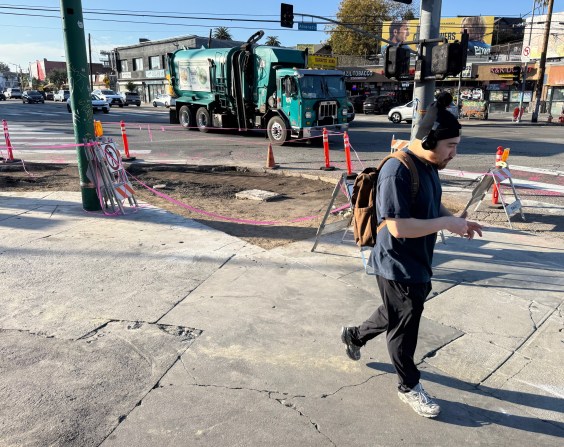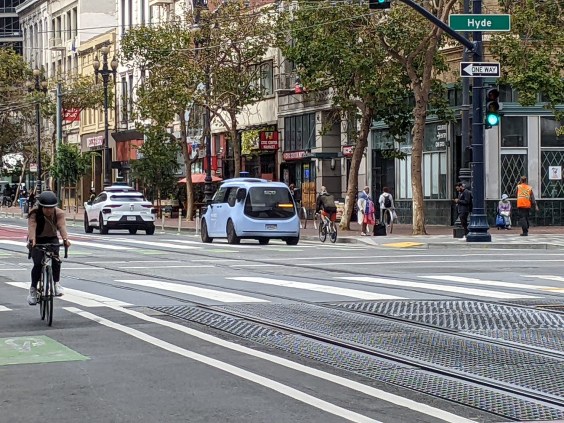Friend of the blog and Streetsie award winner Luke Klipp recently posted a dozen tweets exploring the various reasons that pedestrian beg buttons are awful. SBLA will give Klipp the floor, and add a few points after his tweet storm:
Let’s talk for a moment about beg buttons…
First: beg buttons are NOT there to serve pedestrians. They exist to serve people in cars. They exist so that car traffic signals can minimize the car travel “delays” associated with people who need to cross a street on foot. (/1)
In order to save people in cars from waiting upwards of 30 seconds for crosswalk signals, city traffic engineers force people on foot to press beg buttons and wait. Always waiting. It’s worth comparing the experience on foot versus behind the wheel. (/2)
People in cars either (a) have the green or (b) wait, typically under a minute, but longer at a few places. They’re in climate-controlled spaces, and the city has spent millions installing in-street coils to automatically detect them without any added effort by a driver. (/3)
Traffic lights are set up to minimize car delays (e.g. “Signal Sync”), with zero consideration for people walking or biking. However, a couple cities (not L.A.) have added “green wave” lights that align with biking speeds on key streets. (/4)
Cities like L.A. have installed beg buttons in part because they have widened their roads and, thus, the time to cross on foot is substantially greater than if those roads were narrower. People crossing on foot require ~3 seconds for each 10-11' lane they must cross. (/5)
The dirty secret of road widenings is that they require longer ped crossing times. This, of course, undermines the whole “purpose” for adding lanes in the first place. It’s also why road “diets” actually can move more cars, because narrower roads have shorter red lights. (/6)
Beg buttons are a reflection of the lengths to which traffic engineers have gone to save people in their cars a few *seconds* here and there, at the expense of added *minutes* here and there for people walking. Beg buttons add minutes of delay for pedestrians. (/7)
Another example of this? All those intersections where there’s a “NO PED CROSSING” sign on one of the four crosswalks. That design saves drivers a minute, maybe two, max. Meanwhile, it forces people on foot to cross three legs of an intersection instead of only one. (/8)
In the past decade, L.A. has instituted two meaningful interventions designed to serve pedestrians and not drivers: (1) zebra-striped crosswalks and (2) Barnes-style all-way crosswalks (like at Hollywood and Highland). (/9)
That the former required a major lift to become city policy (even though it’s relatively cheap) and the latter has been implemented at maybe only a half-dozen crosswalks in a 500 square mile city says a lot about the priority we give to these life-saving interventions. (/10)
Meanwhile, @LADOTOfficial has been adding beg buttons at intersections all across the city, including (and this is the reason for this discussion in the first place) locations with so many pedestrians that it defies logic to even require them at all. (/11)
These actions defy logic, unless your priority is moving cars. And for those of us who walk on a daily basis, it is abundantly apparent that moving cars - above all else - is LA’s number one priority, and has been for many years. (/12)
Beg buttons are inconsistent in their timing, often quite dirty, hard to tell if they’re working, and also not ADA friendly, but then they don’t exist for people walking. Beg buttons exist to make the drives of people in their cars more convenient. (/end)
Well said.
Sadly, L.A. is still adding beg buttons, even along MyFigueroa, a complete streets upgrade meant to connect two highly walkable places - a downtown and a university. Readers have recently reported that downtown pedestrians at 7th Street and Figueroa Street (a very heavily walked intersection at the portal where four Metro rail lines and numerous bus lines converge) have been delayed for a phase, because nobody expects to have to push a button there. Mercifully, LADOT, after constructive criticism from advocates, is upgrading several of the busiest intersections - removing beg buttons - in the northern end of MyFig.
In this writer's Koreatown neighborhood, the most heavily-walked intersections generally don't have beg buttons, so thanks LADOT for not doing them everywhere.
There are plenty of reasons not to widen roads. Not the least of which, as Klipp points out, is that wider roads mean drivers have to wait longer at intersections while pedestrians get across. Theoretically, road widening is supposed to add car throughput and capacity, but the increased time to walk further across negates this supposed advantage. In an email, Klipp stated "road widenings may do about as much harm to their intended purpose as any good, but they do certainly give people free license to drive faster in between signals, which makes streets less safe." Nonetheless, L.A. is still widening streets, making them harder to cross, less safe, and more expensive to maintain - even along transit-rich corridors like Wilshire Boulevard. Metro and Caltrans are still spending billions to widen freeways, too - which includes making lots of nearby surface streets wider and even more hostile to walking.
A minor caveat that doesn't negate Klipp's overall point: in tweet 9 he mentions only two meaningful L.A. City interventions to serve pedestrians - scrambles and zebra crosswalks. While the city's interventions have, on balance, favored people in cars, there are several other worthwhile interventions that LADOT has implemented, including: leading pedestrian intervals, road diets, mid-block crossings, and People St plazas. More of these, please! And fewer beg buttons.






